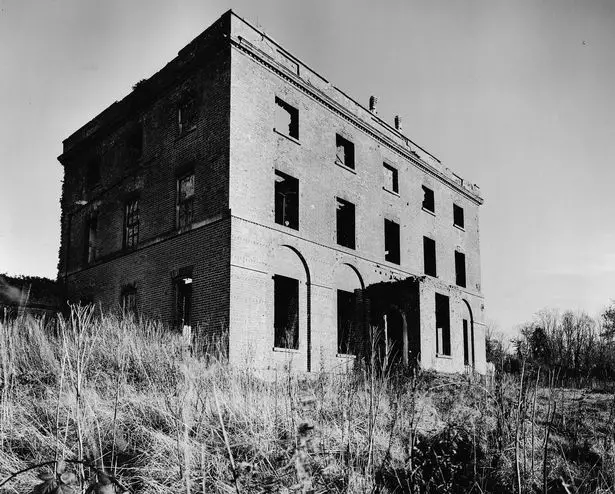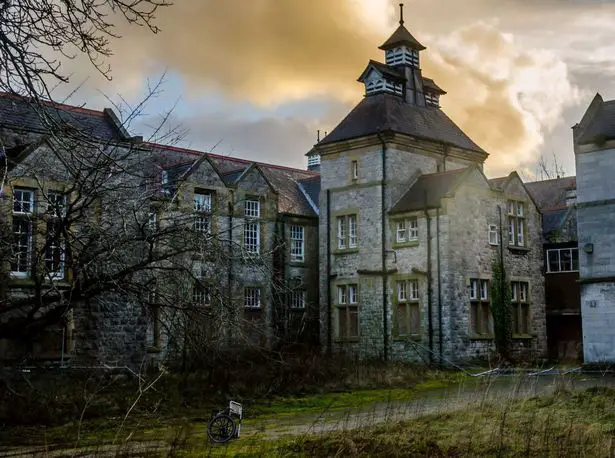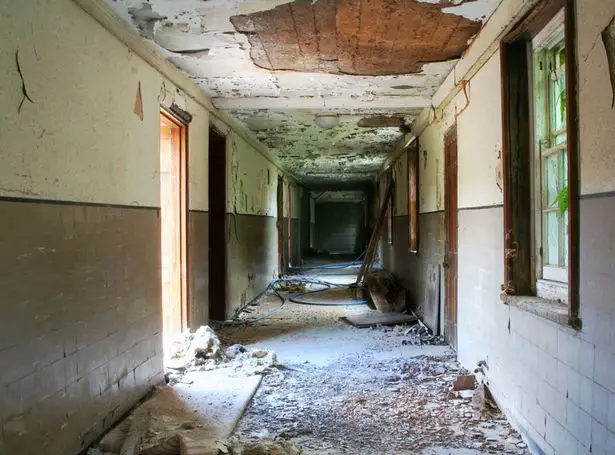Once upon a time, these places were vibrant and bustling, but over the years, they’ve succumbed to the forces of nature, falling into disrepair or being swallowed up by the wild.
In reality, all across Wales, you can find neglected and rundown homes where time seems to have come to a halt since the last person to live or care for them closed the door and walked away.
These places remain hidden within forests, behind old rusty gates, or in quiet corners of forgotten fields. Sometimes, though, someone stumbles upon them once again, revealing their forgotten existence.
Hall of Hafodunos


Hafodunos Hall in Conwy has this incredible old garden that’s making a comeback after being ignored for three decades and even surviving an arson attack. This garden was set up as part of the National Garden Scheme, which is pretty cool.
The place itself was designed by a talented architect named Sir George Gilbert Scott. He gave it this cool Gothic style. It was built between 1861 and 1866 for a guy named Henry Robertson Sandbach. He wanted to replace an older house that was built back in 1674.
At some point, the Sandbach family sold the place. Then it became home to Kent House School for Girls. The school was originally in Sale, but they bought Hafodunos to use as a safe spot during World War II.
Kinmel Hall

Kinmel Hall, often referred to as the ‘Welsh Versailles,’ was once a breathtaking mansion that graced our country. However, times have changed, and now it’s a shadow of its former self, left to crumble and decay.
This place has a rich history, going way back to the 12th century when it started as a private residence. The building we see today, with an impressive 122 rooms and a Grade I listing, was completed in 1876. It was made possible by Robert Hughes, who had a huge fortune from copper mining passed down to him.
Over the years, Kinmel Hall has worn many hats. It wasn’t just a residence; it transformed into a boys’ school, a wellness spa, a military hospital, a hotel, and even a hub for Christian conferences. Eventually, it became a family home once more, until 1929.
But here’s a glimmer of hope: there’s a plan in motion to restore this once-grand building to its former glory. It’s estimated that this ambitious project will require a substantial £20 million investment.
Plas Glynllifon


Back in the 1830s and 1840s, Plas Glynllifon, a grand neo-classical mansion, was put up by Lord Newborough. This place is right at the heart of a historic estate that has played a big role in shaping the landscapes and communities of Caernarfonshire over time.
Interestingly, even the Prince of Wales Investiture Ball happened there in 1969. But, truth be told, the estate went through a period of abandonment after an earlier attempt to create a wedding venue didn’t work out.
However, things took a turn in 2016 when Paul and Rowena Williams stepped in. They bought this impressive 102-room property and shared their big plans of transforming it into a top-notch five-star hotel. If you’re curious about Wales’ top 50 hotels or the finest dining spots in the country, this is the place to look.
Cwrt

You can stumble upon this abandoned house in Llanychaer, Pembrokeshire. Even though it’s looking pretty run-down on the outside, surprisingly, the roof is still holding up strong. Urban Ghosts Media confirms this fact.
Interesting bit of history: way back in 1811, Richard Fenton’s Tour of Pembrokeshire book described this place as a “beautiful contemporary residence.”
As for now, according to Urban Ghosts Media, the outbuildings of the house have also fallen into disrepair. And if you take a look at the scene, you’ll see a tree stump right at the front – that’s all that’s left of a cedar tree that originally came from the Holy Land.
Edwinsford House

Edwinsford House, which holds a Grade II listing, used to be the home of Sir Rice Williams, who was quite the bigwig as the high sheriff of Carmarthenshire back in the 1680s.
The construction of this place goes way back to 1635, situated on the left side of the River Cothi, a bit north of Llandeilo. Unfortunately, things went downhill from there, and by the time the 1970s rolled around, the house had fallen into disrepair and ruin.
Cornist Hall


Cornist Hall, close to Flint, holds the distinction of being the birthplace of a naval admiral who was a part of Lord Nelson’s crew. However, this place has been empty for a while now, and sadly, it’s become a favorite spot for vandals to wreak havoc.
This building used to be the family residence of Thomas Totty, who was part of Lord Nelson’s team on various ships, most notably the HMS Invincible, during the 18th century. As history went on, Cornist Hall took on different roles – it was even used as a place for dining and weddings until 2013 when it closed its doors.
Interestingly, the Summers family, who were connected to John Summers & Sons Ltd, a significant iron and steel manufacturer in Shotton, were initially in charge of this place. The story took a twist when Clwyd Council took over and turned it into a catering venue in 1953. However, by 1987, it was back in private hands, having been sold to a new owner.
Golden Grove


In Carmarthenshire, there’s this estate that’s seen three different mansions come and go. The first one was put together by the Vaughan family around 1560. Unfortunately, it was destroyed in a fire in 1754, but they didn’t give up – they rebuilt it. Then, in 1804, John Vaughan, the last of the Golden Grove Vaughans, left the estate to his friend from Oxford, John Frederick Campbell. This friend later became Lord Cawdor of Castlemartin and eventually the first Earl Cawdor. This new Earl decided to shake things up – he tore down the old place and had a new house built. He got the renowned architect Sir Jeffry Wyatville to design it.
From that point on, Golden Grove was in the hands of the Cawdor family until 1935. It had quite a journey during World War II – it was even taken over by the US Air Force for a while. And then, from 2003, it served a different purpose as an agricultural college under Coleg Sir Gar.
Ruperra Castle


Back in 1626, a guy named Sir Thomas Morgan decided to put up this castle in Caerphilly. It was kind of special because it was one of the first “mock” Tudor castles in Wales – you know, the type that looked like the old ones but were actually newly built. Fast forward to 1645, and even King Charles I spent a couple of nights there, which must have been a big deal.
As time went on, the castle changed hands. In the 18th century, a wealthy merchant named John Morgan bought it and made it his home. It became part of the Morgan family’s Tredegar holdings. But then, a major hiccup – in 1785, a fire wreaked havoc on the place. Thankfully, they didn’t give up, and they rebuilt it, using it as a residence again.
After dealing with legal troubles regarding the property for years, they finally decided to sell it in 2010. The price tag? A cool £1.5 million.
Iscoed


Near Ferryside in Carmarthenshire, there’s a place called Iscoed that was once an impressive palace from the 18th century. A clever architect named Anthony Keck was behind its design, and it was raised in 1772 for a person named Sir William Mansel. Later, in 1812, it was snapped up by Sir Thomas Picton, a Napoleonic commander. It stayed in their family until World War One rolled around.
After that, things took a turn. It was turned into council housing for a while, but eventually, it became empty and started to fall apart, like a once-lively party that had come to an end. It’s been standing there in a sad state since the 1950s, slowly becoming a shadow of its former self. In 2018, it even went up for auction, but sadly, there were no takers.
Great Frampton

Great Frampton is a house that got a fancy new front in the late 1700s, but it’s actually sitting on a much older home from the 16th century. Sadly, things took a bad turn in the late 1990s when a fire tore through the place, leaving it pretty much just an empty shell.
Interesting tidbit: back in the 1770s, a well-known astronomer named Nathaniel Pigott made himself at home in Frampton, which is near Llantwit Major. He even set up his own observatory there. And to add a bit of charm, Great Frampton has a walled garden – quite a nice touch.
Red Dress Manor



In Llanymynech, Powys, there’s this impressive old dairy farm that, at first glance, seems like someone still lives there. If not for all the years of dust covering stuff like pictures, lights, and clothes, you’d almost believe it’s a bustling home. What’s pretty cool is that there are still portraits of the person who used to own the place hanging on the walls. And get this – the old clothing that gave the manor its name is still around, even though the place itself has seen better days.
This dairy farm has quite a history. It was built around 1725, so you can imagine the stories it could tell. In 2013, a photographer managed to get inside and took some seriously amazing pictures of the place.
Piercefield House


This architectural marvel at St Arvans, in the Monmouthshire countryside, was created by British architect John Soane – the man behind the Bank of England building – and was hailed as a neoclassical masterpiece when it was erected in the late 1700s.
It was once a location for US troops to perform D-Day Landings drills in 1944, overlooking 129 acres of parkland. Despite being purchased in recent years by wealthy property developer twins David and Simon Reuben, it has remained derelict since then.
Gwrych Castle

Gwrych Castle is a place with a really fascinating and diverse history, and it even has some connections to the British Royal Family. It was put up by Lloyd Hesketh Bamford-Hesketh between 1810 and 1822. He actually combined it with his family’s old house. This castle was a big deal – lots of famous architects were involved in its creation, and it was actually the biggest newly built structure of the entire 19th century. Just to give you an idea of its size, the front is over 1,500 feet long and it has 18 towers with battlements. From up there, you can get amazing views of the countryside and the Irish Sea.
This castle was the heart of Abergele in Conwy, and it’s said to have had around 120 rooms and even a grand marble staircase. People think it’s one of the finest examples of stunning architecture in all of Britain. But here’s the thing – for about fifty years, the castle’s future was uncertain, and it even got dangerously close to falling apart. Luckily, things have taken a positive turn. The Gwrych Castle Preservation Trust came in and bought it. Their aim? To give this historic place a new lease on life by opening it up for the public to enjoy
Baron Hill


B ack in 1618, the Bulkeley family, a pretty well-known bunch in north Wales, put up this place. But as time went on, things changed. By 1776, the 7th Viscount of Bulkeley, who was also the very first and last Baron of Beaumaris, decided to give the place a makeover. He hired architect Samuel Wyatt to give it a Neo-Palladian style facelift.
This place was the family’s home for quite a while, all the way up to the 1920s. But then, they decided to move to a more modest spot, and this grand place turned into a storage spot.
When World War II started, things got even more interesting. The government took over and used it as a place for Polish soldiers to stay.
Sadly, the home in Beaumaris and its nearby buildings haven’t aged well. Time hasn’t been kind, and now they’re without roofs and kind of lost in a sea of trees.
There was some big talk in 2007 about turning this Grade II listed building into 43 flats. Developers like Watkin Jones, Sir Richard Williams-Bulkeley, and the Baron Hill Estate were all part of the plan. But as things often go, the project never actually happened.
Cilgwyn


Cilgwyn House used to be quite the big deal, owning a large chunk of land in Carmarthenshire and Cardiganshire. The Cilgwyn that stands today was put up in 1870.
Paul White, a postman from West Wales, has made it his mission to capture photos of old and worn-down houses. His shots often have this eerie, spooky vibe, just like the one you’re looking at here. You can check out more of his work right here.
Paul shared, “Being a postman makes it a bit easier to come across these places. Otherwise, I’d spend hours poring over reference books and maps, trying to figure out where these abandoned spots might be.”
He also mentioned, “And you know, usually, I spot them pretty quickly – the unmistakable signs of a forgotten place, like old electrical poles or driveways that haven’t seen any action in ages.”
RECOMMENDED: A List Of Some Of The Most Amazing & Eerie Abandoned Places Worldwide
Denbigh Hospital


Denbigh Hospital might not be a palace, but let me tell you, it’s one of the most jaw-dropping abandoned places you’ll find in Wales. They put it up between 1846 and 1848, and back in the day, it used to be home to around 200 patients. This mental facility up in North Wales got a Grade II listing, which is kind of a big deal. But sadly, it shut down in 1996, and then things took a turn for the worse – a bunch of fires ripped through it, leaving it hanging on the edge of collapse.
Now, here’s a bit of interesting news. A multi-millionaire named Lawrence Kenwright, who’s got quite the wallet, mentioned earlier this year that he’s got a plan. He wants to transform this place into not one, but two luxury hotels and some fancy houses. Cool, right?
And if you’re curious about the history of abandoned asylums in Wales, you can find out more here. Get ready to learn about the tough times and the stories of the folks who lived in the Glamorgan County Lunatic Asylum – it’s quite a ride.
Mid Wales Hospital


Here’s another piece of history – a place from the Victorian era, built back in the early 1900s and then calling it a day in 1999. This spot had a lot going on – kitchens, workshops, a bakery, a tailor, even printing businesses. And believe it or not, they had eight acres of market gardens too – that’s a whole lot of space!
Originally, it was called the Brecon and Radnor Counties Joint Lunatic Asylum – quite a mouthful, right?
But there’s a somber side to it as well. It’s been said that at least one patient lost their life right there due to a pre-frontal lobotomy.